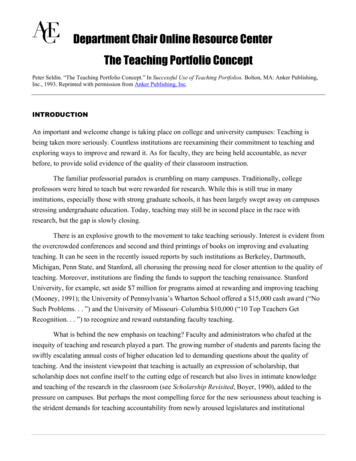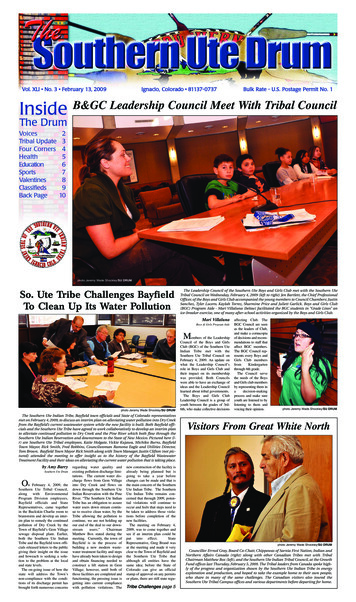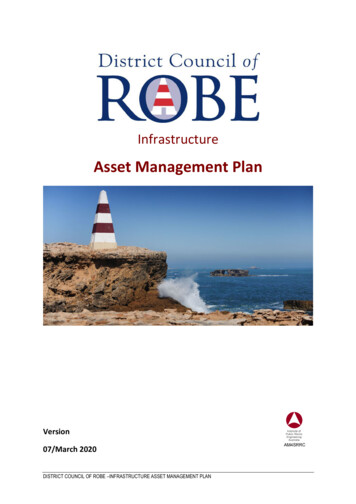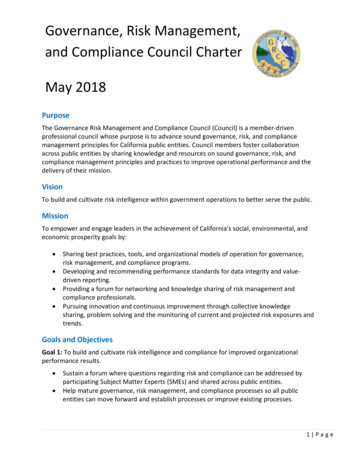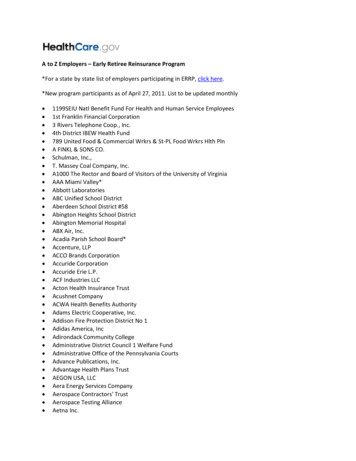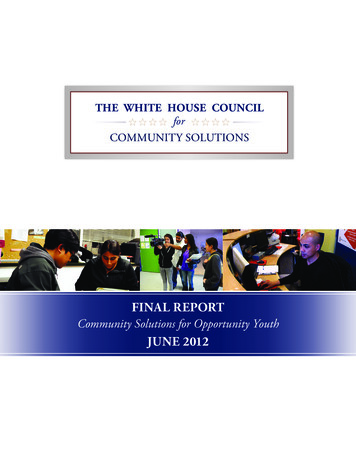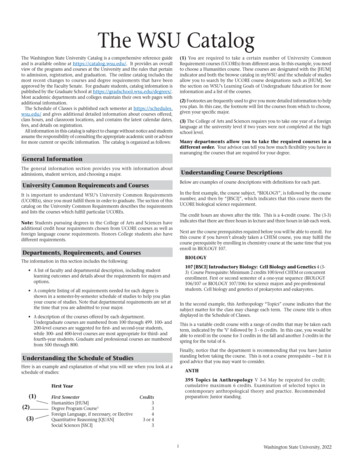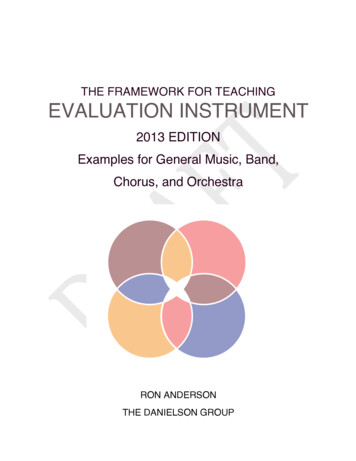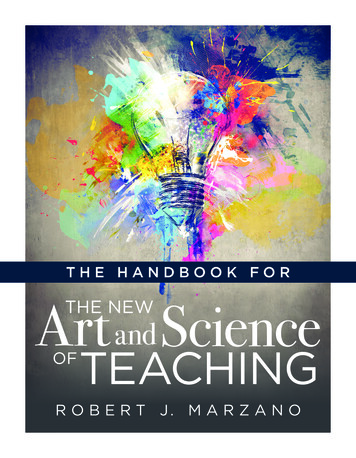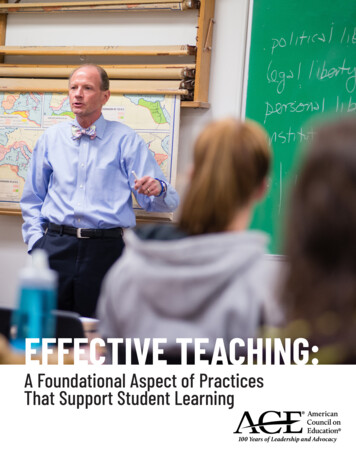
Transcription
EFFECTIVE TEACHING:A Foundational Aspect of PracticesThat Support Student Learning100 Years of Leadership and Advocacy
Brice StruthersAmerican Council on EducationPenny MacCormackAssociation of College and University EducatorsSteven C. TaylorAmerican Council on EducationWilmington University (DE)Cover photo courtesy of ACE member institution Roanoke College (VA).100 Years of Leadership and AdvocacyACE and the American Council on Education are registered marks of the American Council on Education and may notbe used or reproduced without the express written permission of ACE.American Council on EducationOne Dupont Circle NWWashington, DC 20036 2018. All rights reserved. No part of this publication may be reproduced or transmitted in any form or by any meanselectronic or mechanical, including photocopying, recording, or by any information storage and retrieval system, without permission in writing from the publisher.
The American Council on Education (ACE), through the generous support of Strada Education Network,is engaged in research on the connections between instructional quality, improved student outcomes, andincreased institutional efficiency. As part of this work, ACE is highlighting practices that support teaching andlearning, and exploring the impact these practices are having at three distinct public colleges and universities—California State University, Fullerton; Indiana University-Purdue University Indianapolis; and Housatonic Community College (CT). This paper provides a brief overview of effective pedagogical practices and explores theoutcomes, challenges, and future strategies associated with their implementation. The authors further examinethe foundational aspect that good teaching plays in implementing evidence-based practices that positivelyaffect student learning and outcomes.Quality instruction directly influences student learning and motivation, pass rates, and subject-matter interest,and positively affects student retention (Haras et al. 2017). Additional research found that effective teachingpractices are a strong predictor of graduation because of their influence on academic achievement (Pascarellaand Terenzini 2005). There are explicit linkages between improvements in student learning and instructors’pedagogical development; thus, instructors are the single most important influence on their students’ successin and outside the classroom (Haras et al. 2017). Examples of effective teaching improving student learninginclude improving pedagogical approaches, assessment, and improving learning environments.Researchers found a link between different types of pedagogical approaches and the enhancement of studentlearning, including active learning, on college campuses (Barrows 1996). A study from Karen Singer-Freemanand Linda Bastone (2016) found that using evidence-based pedagogical practices like active learning led toincreased retention for underserved students. Improving instruction also includes improving assessment, akey mechanism for helping students learn. Evans (2013) found that receiving feedback from multiple sources,as a form of assessment, led to students becoming more self-regulated learners. Self-regulated learners, onesthat use reflection to find meaning in the coursework, are more likely to graduate and persist (Jankowski 2017).This indicates that “active participation of students in their learning is a necessary component of the interaction between instruction and student outcomes” (Jankowski 2017, 8). All of these approaches point to studentsuccess as an important dependent variable of effective teaching.George D. Kuh put forth a set of 10 high-impact practices (HIPs)—benchmark practices that focus on improvingteaching and learning—in a 2008 report titled High-Impact Educational Practices: What They Are, Who HasAccess to Them, and Why They Matter. The 10 HIPs Kuh identified are first-year experiences and seminars,common intellectual experiences, learning communities, writing-intensive courses, collaborative assignments,undergraduate research, diversity and global learning, service learning, community-based learning, internships,and capstone courses and projects. However, not all institutions offer students the opportunities to engage inprimary research, study abroad, service- or community-based learning, internships, or capstone courses, nor doall students engage in these activities if they are available. Therefore, in the following case studies, we focus onthe first five of the previously listed HIPs, which we believe center on effective pedagogy, a necessary component of HIPs, and have higher potential to reach more significant numbers and a greater diversity of students.What follows are three case studies, each highlighting the implementation of at least one of the first five HIPs—first-year experiences and seminars, common intellectual experiences, learning communities, writing-intensivecourses, and collaborative assignments—as well as other practices tailored specifically to the institution’s mission and student population.1
CALIFORNIA STATE UNIVERSITY, FULLERTONPhoto courtesy of California State University, Fullerton.California State University, Fullerton (CSUF), part of the nation’s largest four-year public university system, is aHispanic-Serving Institution with 4,100 full- and part-time faculty and staff, and roughly 40,000 students (TheCalifornia State University 2016), 46 percent of whom are Pell Grant recipients (National Center for EducationStatistics 2016). CSUF contributes significantly to the state’s economy, generating 2.26 billion in economicactivity annually and sustaining more than 15,000 jobs in the region (California State University, Fullerton2017c). CSUF has become an emerging national model for supporting student success through innovativehigh-impact educational and co-curricular experiences, including faculty-student collaborative research. Theuniversity’s undergraduate demographic data demonstrates that the campus-wide implementation of HIPs wasa natural choice for CSUF to help enhance student learning, reduce the achievement gap, and increase retention and graduation rates (Swarat and Sullivan 2015).The institution already utilizes several practices to address the needs of the student population; for example,supplemental instruction has been widely implemented. Supplemental Instruction (SI) provides students witha systematic and disciplined approach for processing the subject material in gateway and historically difficultcourses—with low pass and high withdrawal rates—accomplished through weekly, peer-led group study sessions(California State University, Fullerton 2017b). In 2015, the SI program received a CSUF Teamwork and Collaboration Award for its work in producing a 25 percent increase in the passing rate of students in bottleneck andgateway courses.Based on CSUF’s history of integrating high-impact practices into courses, the university established in 2013a HIPs Task Force to define and assess HIPs, and—more importantly—to develop a system for creating a“HIPs campus” (CSUF 2013). The plan focuses on the establishment of a model for identifying and evaluatinghigh-impact practices around learning outcomes, retention, and graduation (CSUF 2013). Leaders also implemented a campus-wide HIPs model called REACH (research, experiential learning, active learning, community,and human exploration) to promote the HIPs mission.2
OUTCOMESBased on data available from CSUF’s Office of Assessment and Institutional Effectiveness (OAIE) and interviews with other campus units responsible for leading the high-impact practices assessment efforts at CSUF, wenote several key outcomes from the REACH initiative. Participation in HIPs contributed to increased retention and graduation rates, as well as reducingthe achievement gap (e.g., students who participated in HIPs classes demonstrated, on average, a 12percent learning gain within a semester). Students self-reported increases in their perceived learninggains, which correlates with the positive learning gains observed by faculty. These learning gainsalso positively correlated with retention. Students reported having satisfactory experiences in their HIPs classes, referencing interaction withfaculty, feedback opportunities, and exposure to experiential learning as key factors positively affecting the experience. Faculty teaching HIPs classes felt part of a collegial community and engaged in self-reflection andpeer reflection on their teaching experience. They also received pedagogical support on coursedevelopment and delivery, timely feedback through the HIPs tracking mechanism, and data analysisspecific to their classes.CHALLENGES AND FUTURE STRATEGIESWith a large campus such as CSUF, the launch process of the HIPs initiative resulted in some challenges(Swarat and Sullivan 2015). CSUF leaders recognized that implementing a HIPs tracking process and integrating data collection would require a systematic and thorough approach to faculty development. This is notdissimilar from the support site leads needed to implement co-curricular HIPs. Regular and sustentative development activities for faculty were put in place to help faculty and co-curricular site leads gain a full understanding of the HIPs components. Recognizing that high-quality instruction utilizing high-impact practices leads toincreased student success rates and satisfaction, CSUF leaders invested in support systems to provide facultyand staff with resources and guidance to implement HIPs into curricular and co-curricular experiences. Further,leaders recognized that to coordinate HIPs implementation among such large numbers of faculty and classesrequires dedicated personnel, so the university designated a full-time HIPs project coordinator to work individually with the faculty on the smooth implementation of HIPs into course design and classroom instruction.Faculty have mostly viewed the experience positively, and some faculty are utilizing HIPs to pursue the scholarship of teaching and learning (SoTL).Higher education leaders and faculty have a critical role in promoting student engagement and success. Institutions that focus on data experience gains in their student success initiatives (Yeado et al. 2014). In the caseof CSUF, the institution has made strides in how it leverages technology (i.e., the iFullerton app) to track HIPsdata and outcomes (Swarat et al. 2017). Former Provost José L. Cruz (2016) encouraged the use of data as a keyfocus on student success. As a result, the university established a digital dashboard of students’ data extractedfrom various data systems across campus; advisors use the dashboard to identify students at risk of delayedgraduation and who might benefit from available support services.3
INDIANA UNIVERSITYPURDUE UNIVERSITY INDIANAPOLISPhoto courtesy of Indiana University-Purdue University Indianapolis.Since its founding in 1969, Indiana University-Purdue University Indianapolis (IUPUI) has been a premierurban research institution. The university boasts a total 2017 student enrollment of 29,790, with an undergraduate enrollment of over 20,000 students. The 2012 edition of U.S. News & World Report’s Best Colleges rankedIUPUI third among national universities in the “up-and-comers” category. The university was also recentlyawarded, for a fifth consecutive year, the Higher Education Excellence in Diversity (HEED) Award fromINSIGHT Into Diversity magazine, the oldest and largest diversity-focused publication in higher education.The HEED award recognizes institutions that have possessed a strong commitment to diversity and inclusionthrough their innovation programs, hiring practices, training curricula, and on-campus support systems. Part ofthe university’s recognition stems from its commitment to high-impact practices such as first-year experience,service learning, and themed learning communities.As part of IUPUI’s strategic planning process in 2008, institutional leaders created the RISE (research, international study, service learning, and experiential learning) program to institutionalize co-curricular learning experiences for college students. The Office of Institutional Research and Decision Support estimates that 5,300students enroll in RISE courses each year (Hansen and Thorington Springer 2017). With this in mind, IUPUIsets specific goals to engage faculty more deeply in HIPs and facilitate faculty members’ ability to researchHIPs and their contribution to student success.IUPUI is committed to providing consistently high quality, high-impact educational experiences for its students. The RISE program enhances institutional strengths to “brand” the unique aspect of an IUPUI undergraduate degree. The experiential pedagogical approaches in the RISE program better prepare students to meet thechallenges they face as students and following graduation, and prepares students as productive citizens (Baker,Fisher, and Johnson 2012).4
OUTCOMESThis paper uses data reported from the IUPUI Office of Institutional Research and Decision Support (IRDS).Based on the various methodologies used by the IRDS to assess the effects of high-impact practices, the datarevealed the following outcomes: Improved student outcomes for RISE participants. Students participating in first-year HIPs wereretained at higher levels, had improved graduation rates, and had a marked increase in GPAs. Faculty at IUPUI have also greatly benefited from the implementation of RISE. Since the campuswide enactment of HIPs, faculty have been more deeply engaged in faculty development activities, have enhanced the quality of HIPs experience for students, and have conducted institutionalresearch on HIPs teaching strategies, particularly at the student level to understand success. Tenure-track faculty reported being more likely to supervise research than other faculty at IUPUI,and lecturers were more likely to teach as part of a themed learning community (TLC). According tothe 2015 IUPUI faculty survey, tenure-track faculty were more likely than lecturers to report requiringan undergraduate research project as part of a course or mentoring an undergraduate student ona research project in the past two years. Lecturers were more likely to report teaching as a part of aTLC, and more than 50 percent of both tenure-track faculty and lecturers reported providing periodicand structured opportunities for reflection. IUPUI has also been able to extend HIPs into student and faculty development with the addition ofePortfolio, the 11th HIP to Kuh’s 10 original practices. The ePortfolio allows for further documentation of student learning, provides students with an opportunity to reflect on their individual growthand development, and functions as a useful institutional tool for accountability and assessment.CHALLENGES AND STRATEGIESDespite the relatively successful implementation of HIPs at IUPUI, the university experienced challenges.Included among the challenges is the fidelity and quality of RISE courses offered. For example, there have beeninconsistencies regarding how schools and departments at IUPUI tag the different components of the RISEacronym. To address these challenges, IUPUI developed taxonomies it will use to increase the quality of teaching using high-impact practices (Hansen, Graunke, and Thorington Springer 2016). Each unit with responsibility for a high-impact teaching practice developed a taxonomy that serves as a framework and acts as a guidefor quality course design, implementation, assessment, and improvement. Additionally, the university will offermore faculty and professional development and peer learning opportunities to promote best practices for HIPsimplementation.Overall, IUPUI administrators believe the taxonomies benefit faculty, staff, and students in several ways. First,the taxonomies can support schedulers and committees who need to tag each RISE course. Second, the taxonomies allow for the quality of the HIPs to be measured and evaluated. Third, taxonomies act as a coursedevelopment guide for instructors interested in creating and improving RISE courses (Hansen, Graunke, andThorington Springer 2016).The taxonomies can also be used as a resource to evaluate faculty applications for course development grantsand other HIPs awards connected to the curriculum. IUPUI will focus on providing more professional development opportunities for faculty and staff, along with greater incentives and rewards for faculty to participate inthe RISE program.5
HOUSATONIC COMMUNITY COLLEGEPhoto courtesy of Housatonic Community College.Housatonic Community College (HCC),1 part of the Connecticut State Colleges and Universities system, is anAchieving the Dream Leader College and was named by the Aspen Institute College Excellence Program asone of the top 150 community colleges eligible to compete for the 2017 Aspen Prize for Community CollegeExcellence. Its student body reflects the diversity of its service region. In fall 2016 HCC enrollment was 5,143students, with 49.8 percent of the students living in Bridgeport, Connecticut, the largest city and a major urbancenter in the state.Many students arrive at Housatonic Community College without the full set of skills necessary for college-levelwork. Each semester, over 60 percent of HCC students test into pre-college level courses in math, reading, orwriting, or all three areas. To ensure that students are supported to meet the challenges of college-level work,HCC has developed and implemented several HIPs, including first-year seminars, supplemental instruction,and academic support and tutoring, provided through the Center for Academic Progress and the WritingAcross the Curriculum Center, both of which were established in 2014. These programs have been successful indemonstrating positive effects on student performance.OUTCOMESThe mission of the Center for Academic Progress (CAP) is to help students placing at or below the developmental course level gain the skills they need to become successful at the college level. The CAP serves studentsseeking to prepare for placement testing, students who place into developmental courses and would like toimprove their skills before enrolling in courses, and students enrolled in intensive developmental courses. Inthe fall semester of 2015:1Information on HCC is pulled from data and content in the 2017 Housatonic Community College NEASCFifth-Year Interim Report.6
Students enrolled in a developmental math course who visited the CAP at least once had a 70 percent success rate (defined as a grade of C or better), compared with 52 percent for students who didnot visit the center. Students enrolled in a developmental English course who visited the CAP at least once had a 67percent success rate, versus 38 percent for students who did not visit the CAP.In the spring 2016 semester, similar success rates were achieved: Students in a developmental math or English course who visited the CAP had success rates of 61percent and 64 percent, respectively, as compared with success rates of 36 percent and 42 percent,respectively, for those who did not visit the CAP.The Writing Across the Curriculum Center (WACC) at Housatonic provides comprehensive assistance to helpstudents write effectively in all subject areas. In addition to one-on-one tutoring, the center provides workshopscovering all aspects of the writing process. Professors can request a workshop during their classes, and the center also holds stand-alone workshops open to all students. The center strives to connect with as many teachingfaculty as possible and to serve students in as many subject areas as possible.Students who visit the WACC obtain a passing grade in gateway courses of English 094, English 101, andEnglish 102 at higher rates than students who do not use WACC resources. The overall pass rate for students enrolled in English 094 was 61.5 percent, and the pass rate forstudents who used the center was 79.7 percent. The overall pass rate for students enrolled in English 101 was 67.8 percent, and the pass rate forstudents who used the center was 77.3 percent. The overall pass rate for students enrolled in English 102 was 57.6 percent, and the pass rate forstudents who used the center was 87.8 percent.The center services also improved student retention. The 2014–15 fall to spring retention rate for all studentswas 73 percent, compared with 83 percent for students who used WACC services.CHALLENGES AND FUTURE STRATEGIESWhile the results from the Center for Academic Progress and the Writing Across the Curriculum Center arepromising, HCC continues to face challenges related to improving student retention and graduation rates. Forexample, in the fall 2015 semester, of the 1,810 students who took the ACCUPLACER (College Board 2017), aplacement test for reading, writing, and math skills, used as part of the enrollment process at Housatonic, just11 percent tested into all college-level courses. To address the continued challenge of fully supporting studentswho are not yet ready for college-level work, the leadership at Housatonic looked more closely at the literatureconnecting evidence-based teaching practices to improved student engagement, motivation, and persistence,noting that “when faculty improve their teaching, students learn more, and their performance on courseworkimproves” (Condon et al. 2016, 125). Put simply, evidence-based teaching practices help students learn moreeffectively. In addition, specific research-based instructional techniques and practices are well-documented andhave been further informed by research on cognition (Ambrose et al. 2010; Angelo and Cross 1993; Bain 2004;Barkley 2009; Brookfield 2006; Chickering and Gamson 1987; Davis 2009; Nilson 2010). Based on this literature,Housatonic has started to include a focus on high-quality classroom instruction as a key part of its strategic plan.7
Housatonic identifies high-quality instruction as a key lever for promoting student success and notes that“adhering to rigorous standards and continually assessing best practices in all areas of the college,” includingclassroom instruction, is a priority for maintaining educational excellence (2017b). Michael B. Brown, formerdean of academic affairs, believes that “high-quality instruction is a foundational best practice undergirdingHIPs and therefore is essential for the HIP practices to realize their full potential” (Brown, personal communication). To ensure that all students receive quality instruction, the college has committed to providing its facultywith opportunities to further develop levels of excellence and effectiveness in teaching.The Center for Teaching (CFT) at Housatonic promotes teaching excellence, sponsoring a variety of professionaldevelopment opportunities in coordination with Connecticut State Colleges and Universities. Over the lastfive years, the CFT has continued its focus on strengthening the sense of community and collaboration amongfaculty and providing regular opportunities for meaningful discussion of teaching and learning. It has also partnered with other on-campus departments and committees to develop programming and increase participation.In the spring of 2017, HCC was one of two community colleges in Connecticut participating in the initialphase of a project designed to enhance faculty and student success. Faculty completed the Course in EffectiveTeaching Practices offered by the Association of College and University Educators (ACUE), which leads to anationally recognized Certificate in Effective College Instruction endorsed by ACE.2 The course is comprehensive, including 25 modules from five units of study: Designing an Effective Course and Class; Establishinga Productive Learning Environment; Using Active Learning Techniques; Promoting Higher Order Thinking;and Assessing to Inform Instruction and Promote Learning, addressing the foundational knowledge and skillsneeded to be effective in the college classroom. In addition, the course is offered online to meet the varied andbusy schedules of faculty and scale efforts to increase the use of evidence-based teaching practices. Finally, toensure faculty have opportunities to learn with and from one another the course is completed in small groupsguided by a campus-based facilitator from the CFT. As faculty members who completed the ACUE trainingmodules, we were instructed to implement various practices throughout the semester. The implementation ofeffective teaching practices allowed for real-time feedback, self-evaluation, and reflection with other colleaguesenrolled in the training. Incorporation of engaging teaching practices increased and enhanced a more stimulating, student-centered, active learning classroom setting. It promoted collaborative efforts between students;it supported critical and creative thinking and problem solving. ACUE encouraged faculty to reexamine coursecontent and learning objectives, and ensure alignment with course outcomes, along with the use of properassessment tools.At the end of the course, faculty responded to the end-of-course survey, which asked about their attitudes,experiences, and learning. The majority of faculty completing the survey were tenured or tenure-track faculty,and all respondents reported that their primary role at the college was teaching. Survey results indicated thatthe faculty found the course content relevant to their experiences as educators and the content helpful in refining their teaching practice, and said they would recommend the course to a friend or colleague. Additionally,faculty reported that they felt more confident implementing research-based teaching techniques as a result ofcompleting the course. Based on these promising results, Housatonic plans to continue the project by offeringmore faculty the opportunity to take the ACUE course with the goal of improving student retention throughenhancing instruction and maximizing the benefit of the HIPs it is currently implementing.2ACE is invested in ACUE’s success and has entered into a landmark collaboration with ACUE to enhancestudent outcomes as part of a national effort to advance effective college instruction through state-of-theart online professional development programs for college instructors.8
BIBLIOGRAPHYAmbrose, Susan A., Michael W. Bridges, Marsha C. Lovett, Michele DiPietro, Richard E. Mayer, and Marie K.Norman. 2010. How Learning Works: Seven Research-Based Principles for Smart Teaching. San Francisco:Jossey-Bass.Angelo, Thomas A., and Patricia K. Cross. 1993. Classroom Assessment Techniques: A Handbook for CollegeTeachers. 2nd ed. San Francisco: Jossey-Bass.Association of American Colleges and Universities. n.d. “Why Students Need Capstones and Signature Work.”Accessed March 17, 2017. ture-work.Bain, Ken. 2004. What the Best College Teachers Do. Cambridge, MA: Harvard University Press.Baker, Sarah, Mary L. Fisher, and Kathy E. Johnson. 2012. “RISE to the IUPUI Challenge: High Impact PracticesFocused on Students’ Success.” Metropolitan Universities 23 (1): 29–40.Barkley, Elizabeth F. 2009. Student Engagement Techniques: A Handbook for College Faculty. San Francisco:Jossey-Bass.Barrows, Howard S. 1996. “Problem-Based Learning in Medicine and Beyond: A Brief Overview.” New Directionsfor Teaching and Learning 1996 (68): 3–12.Brookfield, Stephen D. 2006. The Skillful Teacher: On Technique, Trust, and Responsiveness in the Classroom.2nd ed. San Francisco: Jossey-Bass.The California State University. 2016. “Two Additional CSU Campuses Become Hispanic Serving Institutions.”September 12, 2016. nstitutions.aspx.California State University, Fullerton. 2017a. “About CSU High Impact Practices.” Last modified April 18, 2017.www.fullerton.edu/hips.California State University, Fullerton. 2017b. “Supplemental Instruction.” Last modified April 14, 2017. http://www.fullerton.edu/si.California State University, Fullerton. 2017c. “2017 Fact Sheet.” Accessed November 23, 2017. http://news.fullerton.edu/ resources/multimedia/factsheet.pdf.California State University, Fullerton (CSUF). 2013. California State University, Fullerton Strategic Plan 2013–2018. Fullerton, CA: CSUF. https://planning.fullerton.edu/ resources/pdf/CSUF-Strategic-Plan.pdf.Chickering, Arthur W., and Zelda F. Gamson. 1987. “Seven Principles for Good Practice in UndergraduateEducation.” American Association for Higher Education Bulletin 39 (7): 3–7.College Board. 2017. “Accurate Placement.” ACCUPLACER. ate-placement.Condon, William, Ellen R. Iverson, Cathryn A. Manduca, Carol Rutz, and Gudrun Willett. 2016. FacultyDevelopment and Student Learning: Assessing the Connections. Bloomington: Indiana University Press.Cruz, José L. 2016. “The Power of Intentionality: Cal State Fullerton’s Strategic Approach to Ensuring Equity.”Diversity & Democracy 19 (1).Davis, Barbara G. 2009. Tools for Teaching. 2nd ed. San Francisco: Jossey-Bass.9
Evans, Carol. 2013. “Making Sense of Assessment Feedback in Higher Education.” Review of EducationalResearch 83 (1): 70–120.Hansen, Michele J., Steven Graunke, and Jennifer Thorington Springer. 2016. “Assessing High-Impact Practicesand RISE Experiences.” Presented at the Indiana Association for Institutional Research (INAIR) AnnualConference, in Indianapolis, IN, April 7.Hansen, Michele J., and Jennifer Thorington Springer. 2017. IUPUI Next Steps in the Assessment of HighImpact Practices (HIPs). Indianapolis: Indiana University–Purdue University Indianapolis.Haras, Catherine, Steven C. Taylor, Mary Deane Sorcinelli, and Linda von Hoene, eds. 2017. InstitutionalCommitment to Teaching Excellence: Assessing the Impacts and Outcomes of Faculty Development.Washington, DC: American Council on Education.Hart Research Associates. 20
Examples of effective teaching improving student learning include improving pedagogical approaches, assessment, and improving learning environments. Researchers found a link between different types of pedagogical approaches and the enhancement of student learning, including active learning, on college campuses (Barrows 1996).

